Increases in Temperature and Precipitation in the Different Regions of the Tarim River Basin Between 1961 and 2021 Show Spatial and Temporal Heterogeneity
Abstract
1. Introduction
2. Materials and Methods
2.1. Data
2.2. Methods
3. Results
3.1. TRB Temporal and Spatial Trends in Temperature and Precipitation
3.2. Differences in Temperature and Precipitation in the Sub-Basins
3.2.1. Differences in Temporal Trends
3.2.2. Differences in Spatial Distribution
3.3. Spatiotemporal Variation Based on ERA5
3.4. Possible Impacts of Global Warming and Climate Indices on the TRB
4. Discussion
5. Conclusions
- (1)
- The TRB experienced significant increases in annual mean temperature (0.2 °C/10a) and precipitation (7.1 mm/10a) from 1961 to 2021, with notable differences in precipitation growth rates among its sub-basins. The first EOF mode (EOF1) for temperature and precipitation showed a consistent change pattern; in comparison, EOF2 displayed the opposite pattern.
- (2)
- Over the past 60 years, the temperature and precipitation in TRB sub-basins have shown significant differences. R5, R6, and R7 exhibited the largest annual mean temperature increase (0.3 °C/10a). R3 showed the highest precipitation increase (12.9 mm/10a), and R8 showed the lowest (1.9 mm/10a).
- (3)
- The ERA5_Land data showed high applicability in the TRB. Sub-basins showed warming trends at varying rates. Precipitation in the eastern Taklimakan Desert, most main streams, and the northern Cherchen River Basin showed a decreasing trend, while other sub-basins showed an increasing trend.
- (4)
- The correlations between global warming and temperature in the TRB sub-basins exceeded 0.5, while those with precipitation amounted to 0.2~0.5. Additionally, AMO showed a positive correlation with TRB temperature, particularly in R3, R4, and R6 (0.7~0.8). AO and NAO had significant negative correlations with TRB temperature, except in R9, while PDO was negatively correlated with TRB temperature, except in R2 and R8. Moreover, AMO, AO, NAO, and PDO significantly influenced precipitation distribution, with varying degrees and directions across sub-basins.
Author Contributions
Funding
Institutional Review Board Statement
Informed Consent Statement
Data Availability Statement
Acknowledgments
Conflicts of Interest
References
- Tollefson, J. Climate change is hitting the planet faster than scientists originally thought. Nature, 28 February 2022. [Google Scholar]
- Abbass, K.; Qasim, M.Z.; Song, H.; Murshed, M.; Mahmood, H.; Younis, I. A review of the global climate change impacts, adaptation, and sustainable mitigation measures. Environ. Sci. Pollut. Res. Int. 2022, 29, 42539–42559. [Google Scholar] [CrossRef] [PubMed]
- IPCC. Climate Change 2021: The Physical Science Basis. Contribution of Working Group I to the Sixth Assessment Report of the Intergovernmental Panel on Climate Change; IPCC: Geneva, Switzerland, 2021. [Google Scholar]
- Xing, Y.; Li, Y.; Bai, P.; Zhuang, J.; Feng, A.; Huang, M.; Yan, H. Spatiotemporal variations of meteorological drought and its dominant factors in different climate regions for the first two decades of the twenty-first century. Theor. Appl. Clim. 2024, 155, 3631–3645. [Google Scholar] [CrossRef]
- Byrne, J.P.; Vitenu-Sackey, P.A. The Macroeconomic Impact of Global and Country-Specific Climate Risk. Environ. Resour. Econ. 2024, 87, 655–682. [Google Scholar] [CrossRef]
- Qin, N.; Wang, J.; Yang, G.; Chen, X.; Liang, H.; Zhang, J. Spatial and temporal variations of extreme precipitation and temperature events for the Southwest China in 1960–2009. Geoenviron. Disasters 2015, 2, 4. [Google Scholar] [CrossRef]
- Zhang, Y.; Liang, C. Analysis of Annual and Seasonal Precipitation Variation in the Qinba Mountain area, China. Sci. Rep. 2020, 10, 961. [Google Scholar] [CrossRef]
- Zhang, A.; Zhao, X. Changes of precipitation pattern in China: 1961–2010. Theor. Appl. Clim. 2022, 148, 1005–1019. [Google Scholar] [CrossRef]
- Wang, Y.; Zhang, W.; Zhang, P.; Tang, L.; Huang, Y.; Feng, N. Spatial and temporal variations of precipitation in Northwest China during 1973–2019. Theor. Appl. Clim. 2024, 155, 1–10. [Google Scholar] [CrossRef]
- Zhao, D.; Gao, X.; Wu, S. Nonuniform variations of precipitation and temperature across China over the period 1960–2015. Int. J. Clim. 2021, 41, 316–327. [Google Scholar] [CrossRef]
- Guo, B.; Zhang, J.; Meng, X.; Xu, T.; Song, Y. Long-term spatio-temporal precipitation variations in China with precipitation surface interpolated by ANUSPLIN. Sci. Rep. 2020, 10, 81. [Google Scholar] [CrossRef]
- Liu, Z.; Wu, G. Quantifying the precipitation—Temperature relationship in China during 1961–2018. Int. J. Clim. 2022, 42, 2656–2669. [Google Scholar] [CrossRef]
- Yang, X.; Li, D.; Yang, Z.; Wu, K.; Ji, L.; Zhou, Z.; Lu, Y. Revealing historical observations and future projections of precipitation over Northwest China based on dynamic downscaled CMIP6 simulations. Front. Earth Sci. 2023, 10, 1090221. [Google Scholar] [CrossRef]
- Gao, J.; Zhou, B.; Zhai, P. Changes in Persistent Precipitation in Northwest China and Related Large-Scale Circulation Features. J. Meteorol. Res. 2023, 37, 604–616. [Google Scholar] [CrossRef]
- Ma, X.; Shi, Y.; Shen, Y.; Yang, B. An Analysis of Climate Changing Trend in Northwest China: Recent and Historical Periods. J. Glaciol. Geocryol. 2003, 25, 672–676. (In Chinese) [Google Scholar]
- Shi, Y.; Shen, Y.; Li, D.; Zhang, G.; Ding, Y. Discussion on the Present Climate Change from Warm-Dry to Warm-Wet in Northwest China. Quat. Sci. 2003, 23, 152–164. (In Chinese) [Google Scholar]
- Zhang, Q.; Yang, J.; Wang, W.; Ma, P.; Lu, G.; Liu, X.; Yu, H.; Fang, F. Climatic Warming and Humidification in the Arid Region of Northwest China: Multi-Scale Characteristics and Impacts on Ecological Vegetation. J. Meteorol. Res. 2021, 35, 113–127. [Google Scholar] [CrossRef]
- Shang, S.; Lian, L.; Ma, T.; Zhang, K.; Han, T. Spatiotemporal Variation of Temperature and Precipitation in Northwest China in Recent 54 Years. Arid. Zone Res. 2018, 35, 68–76. (In Chinese) [Google Scholar]
- Wei, S.; Wang, X.; Wang, K.; Liu, L.; Liang, B.; Zhao, W. Rethinking spatiotemporal variations in air temperature over the Qilian Mountains, Western China, from 1979 to 2018. Atmos. Res. 2023, 286, 106671. [Google Scholar] [CrossRef]
- Tang, S. Spatiotemporal Variations of the Temperature and Precipitation in Xinjiang During the Past 40 Years. Master’s Thesis, Sichuan Normal University, Chengdu, China, 2021. (In Chinese). [Google Scholar]
- Wang, L.; Wang, Z.; Liu, M.; Shen, J.; Nie, Z. The temperature and precipitation change and its impact on lakes in Badain Jaran Desert over the last 60 years. Geol. Bull. China 2023, 42, 1218–1227. [Google Scholar]
- Wang, Q.; Zhai, P.; Qin, D. New perspectives on ‘warming–wetting’ trend in Xinjiang, China. Adv. Clim. Chang. Res. 2020, 11, 252–260. [Google Scholar] [CrossRef]
- Zhang, H.; Wang, F.; Zhan, Z.; Xue, P.; Qiu, F.; Hou, W. The Variation Characteristics of Temperature and Precipitation in Mogao Grottoes of Dunhuang in Recent 30 Years. Plateau Meteorol. 2023, 42, 1069–1077. (In Chinese) [Google Scholar]
- Chen, Y.; Xu, C.; Chen, Y.; Liu, Y.; Li, W. Progress, challenges and prospects of eco-hydrological studies in the Tarim river basin of Xinjiang, China. Environ. Manag. 2013, 51, 138–153. [Google Scholar] [CrossRef] [PubMed]
- Bai, J.; Li, J.; Bao, A.; Chang, C. Spatial-temporal variations of ecological vulnerability in the Tarim River Basin, Northwest China. J. Arid. Land 2021, 13, 814–834. [Google Scholar] [CrossRef]
- Wang, Z.; Huang, S.; Mu, Z.; Leng, G.; Duan, W.; Ling, H.; Xu, J.; Zheng, X.; Li, P.; Li, Z.; et al. Relative humidity and solar radiation exacerbate snow drought risk in the headstreams of the Tarim River. Atmos. Res. 2024, 297, 107091. [Google Scholar] [CrossRef]
- Chen, Y.; Xu, Z. Plausible impact of global climate change on water resources in the Tarim River Basin. Sci. China Ser. D Earth Sci. 2005, 48, 65–73. [Google Scholar] [CrossRef]
- Xu, J.; Chen, Y.; Li, W.; Ji, M.; Dong, S.; Hong, Y. Wavelet analysis and nonparametric test for climate change in Tarim River Basin of Xinjiang during 1959–2006. Chin. Geogr. Sci 2009, 19, 306–313. [Google Scholar] [CrossRef]
- Milošević, D.; Stojsavljević, R.; Szabó, S.; Stankov, U.; Savić, S.; Mitrović, L. Spatio-Temporal Variability of Precipitation over the Western Balkan Countries and Its Links with the Atmospheric Circulation Patterns. J. Geogr. Inst. Jovan Cvijic 2021, 71, 29–42. [Google Scholar] [CrossRef]
- Zhu, J.; Chen, Y.; Li, Z.; Duan, W.; Fang, G.; Wang, C.; He, G.; Wei, W. Using Film-Mulched Drip Irrigation to Improve the Irrigation Water Productivity of Cotton in the Tarim River Basin, Central Asia. Remote Sens. 2023, 15, 4615. [Google Scholar] [CrossRef]
- Xu, Z.; Liu, Z.; Fu, G.; Chen, Y. Trends of major hydroclimatic variables in the Tarim River basin during the past 50 years. J. Arid Environ. 2010, 74, 256–267. [Google Scholar] [CrossRef]
- Krysanova, V.; Wortmann, M.; Bolch, T.; Merz, B.; Duethmann, D.; Walter, J.; Huang, S.; Tong, J.; Buda, S.; Kundzewicz, Z.W. Analysis of current trends in climate parameters, river discharge and glaciers in the Aksu River basin (Central Asia). Hydrol. Sci. J. 2015, 60, 566–590. [Google Scholar] [CrossRef]
- Zhang, J.; Bao, W.; Feng, X.; Lu, J.; Luo, Q. Study on the Change of Meteorological Elements in Tarim River Basin in Recent 50 Years. Water Power 2020, 46, 28–34. (In Chinese) [Google Scholar]
- Weihong, L.; Chenggang, Z.; Yapeng, C. Recent changes in the water and ecological condition at the arid Tarim River Basin. In Proceedings of the 25th International Congress on Modelling and Simulation, Darwin, NT, Australia, 9–14 July 2023. [Google Scholar]
- Li, Y.; Chen, Y.; Chen, Y.; Duan, W.; Wang, J.; Wang, X. Characteristics of Dry and Wet Changes and Future Trends in the Tarim River Basin Based on the Standardized Precipitation Evapotranspiration Index. Water 2024, 16, 880. [Google Scholar] [CrossRef]
- Zhang, S.; Wang, Y.; Wang, Y.; Li, Z.; Hou, Y. Spatiotemporal Evolution and Influencing Mechanisms of Ecosystem Service Value in the Tarim River Basin, Northwest China. Remote Sens. 2023, 15, 591. [Google Scholar] [CrossRef]
- Wang, Y.; Zi, F.; Lu, S.; Li, M.; Zhou, J.; Yang, X.; Wang, W.; Niu, R. Analysis of surface-groundwater changes in the Tarim River Basin of Xinjiang from 1989 to 2019. Sci. Geogr. Sin. 2023, 43, 899–909. (In Chinese) [Google Scholar]
- Hou, Y.; Chen, Y.; Ding, J.; Li, Z.; Li, Y.; Sun, F. Ecological Impacts of Land Use Change in the Arid Tarim River Basin of China. Remote Sens. 2022, 14, 1894. [Google Scholar] [CrossRef]
- Xu, Z.X.; Chen, Y.N.; Li, J.Y. Impact of climate change on water resources in the Tarim River basin. Water Resour. Manag. 2004, 18, 439–458. [Google Scholar] [CrossRef]
- Worku, M.A.; Feyisa, G.L.; Beketie, K.T. Climate trend analysis for a semi-arid Borana zone in southern Ethiopia during 1981–2018. Environ. Syst. Res. 2022, 11, 2. [Google Scholar] [CrossRef]
- Xia, Z.; Liao, K.; Guo, L.; Chen, X.; Liu, C.; Jiao, Y.; Cao, J. Spatiotemporal Distribution Pattern of Precipitation in Ganjiang River Basin Based on EOF and MK Trend Analysis. Res. Soil Water Conserv. 2023, 30, 223–233, 249. (In Chinese) [Google Scholar]
- Yuhao, Z. Temporal and spatial distribution characteristics of multi-year rainfall and temperature in Jiangsu Province based on EOF. Water Resour. Plan. Des. 2024. (In Chinese) [Google Scholar] [CrossRef]
- Alemu, Z.A.; Dioha, M.O. Climate change and trend analysis of temperature: The case of Addis Ababa, Ethiopia. Environ. Syst. Res. 2020, 9, 27. [Google Scholar] [CrossRef]
- Aihaiti, A.; Jiang, Z.; Li, Y.; Tao, L.; Zhu, L.; Zhang, J. The global warming and IPO impacts on summer extreme precipitation in China. Clim. Dyn. 2023, 60, 3369–3384. [Google Scholar] [CrossRef]
- Haynes, R.J.; Beare, M.H. Influence of six crop species on aggregate stability and some labile organic matter fractions. Soil Biol. Biochem. 1997, 29, 1647–1653. [Google Scholar] [CrossRef]
- Huang, W.; Chen, F.; Feng, S.; Chen, J.; Zhang, X. Interannual precipitation variations in the mid-latitude Asia and their association with large-scale atmospheric circulation. Chin. Sci. Bull. 2013, 58, 3962–3968. [Google Scholar] [CrossRef]
- Meng, L.; Zhao, Y.; Li, M. Effects of Whole SST Anomaly in the Tropical Indian Ocean on Summer Rainfall Over Central Asia. Front. Earth Sci. 2021, 9, 738066. [Google Scholar] [CrossRef]
- Zhang, L. Analysis of variation trend of rainfall runoff in Keriya River basin. Gansu Water Conserv. Hydropower Technol. 2011, 47, 7–8. (In Chinese) [Google Scholar]
- Zheng, P.; Chen, Y.; Wang, H.; Yang, Y. The impact of climate change on extreme runoffs in the Tianshan region: Taking Kaidu River as an example. J. Irrig. Drain. 2024, 43, 105–112. (In Chinese) [Google Scholar]
- Huang, X. Analysis of the change of Tarim River main stream and climate factors based on set pair analysis. Hydro Sci. Cold Zone Eng. 2024, 7, 79–84. (In Chinese) [Google Scholar]
- Ren, C. Effects of Climate and Land Use Change on Runoff in Yerqiang River Basin. Master’s Thesis, Shihezi University, Shihezi, China, 2021. (In Chinese). [Google Scholar]
- Wang, P.; Xu, M.; Han, H.; Li, Z.; Song, X.; Zhou, W. Response of glacier mass balance and meltwater runoff to climate change in the Akesu River Basin, Southern Tianshan. Earth Sci. Front. 2024, 31. (In Chinese) [Google Scholar] [CrossRef]
- Zhu, J.S.; Zhang, Z.; Chen, H.; Zhong, X. Analysis of Temporal-spatial Variations of 61 Years Summer Precipitation in Haihe River Basin based on EOF and REOF. Haihe Water Resour. 2017, 1–6. (In Chinese) [Google Scholar] [CrossRef]
- Zhou, G.; Chen, Y.; Yao, J. Variations in Precipitation and Temperature in Xinjiang (Northwest China) and Their Connection to Atmospheric Circulation. Front. Environ. Sci. 2023, 10, 1082713. [Google Scholar] [CrossRef]
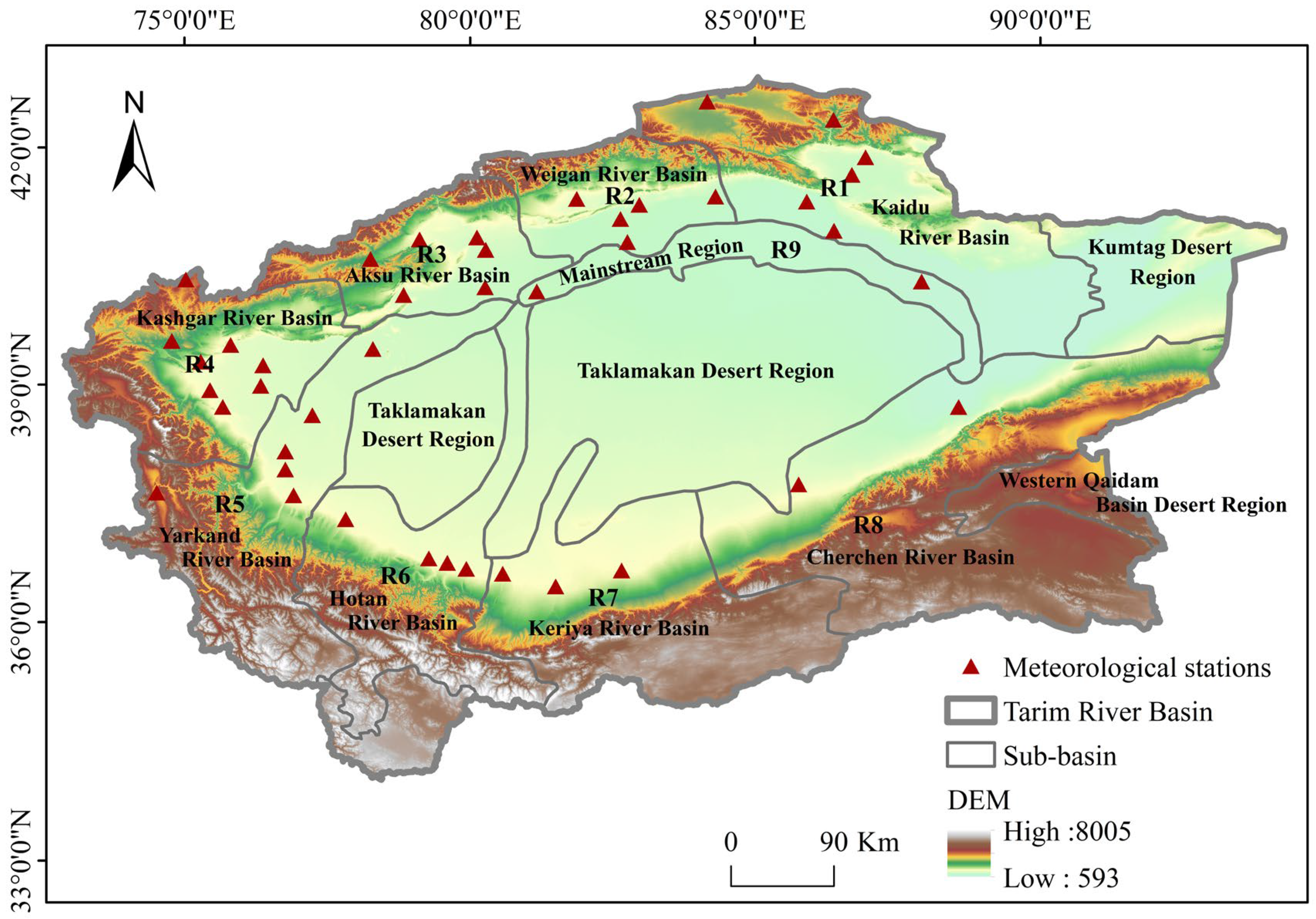
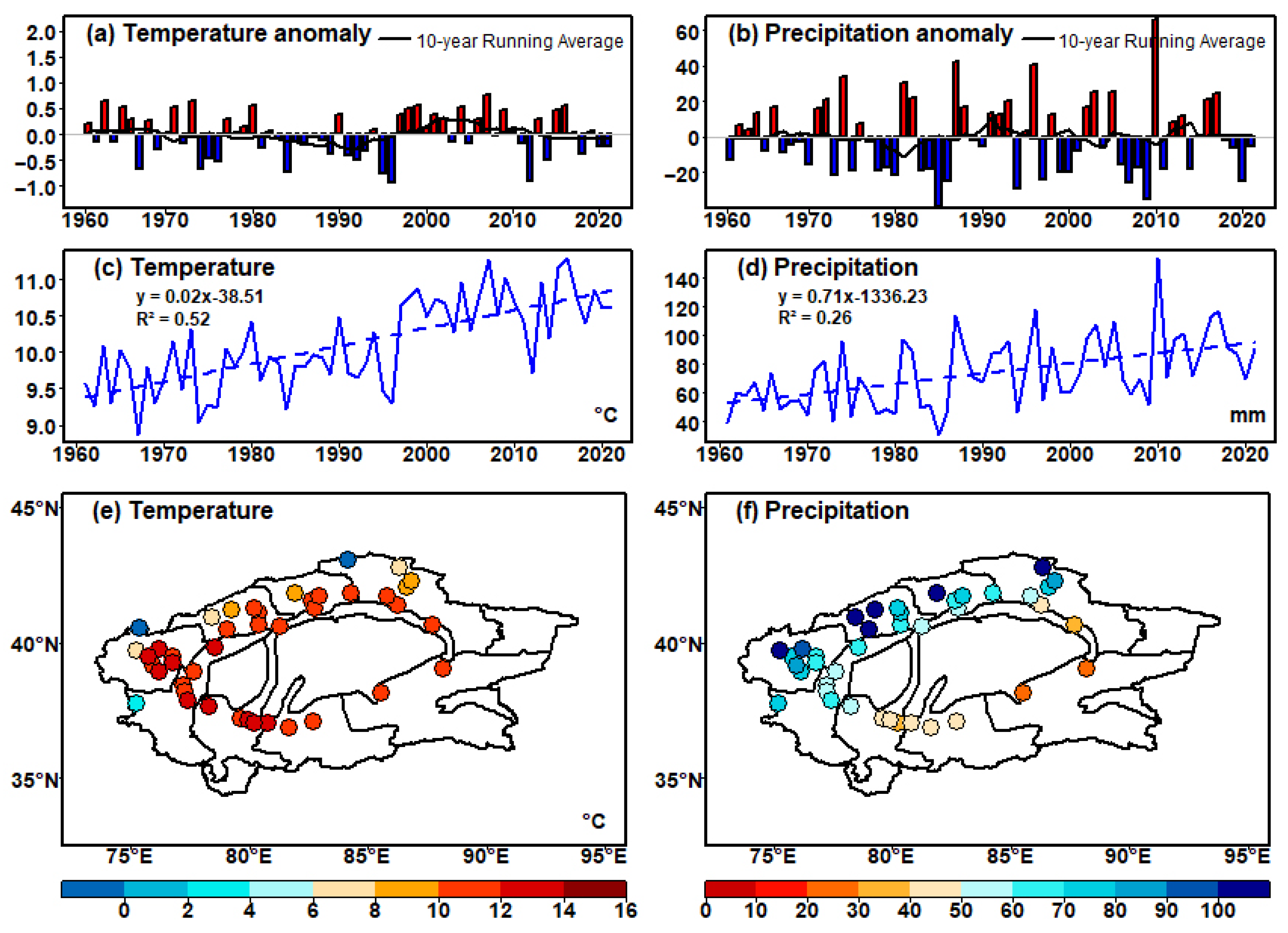
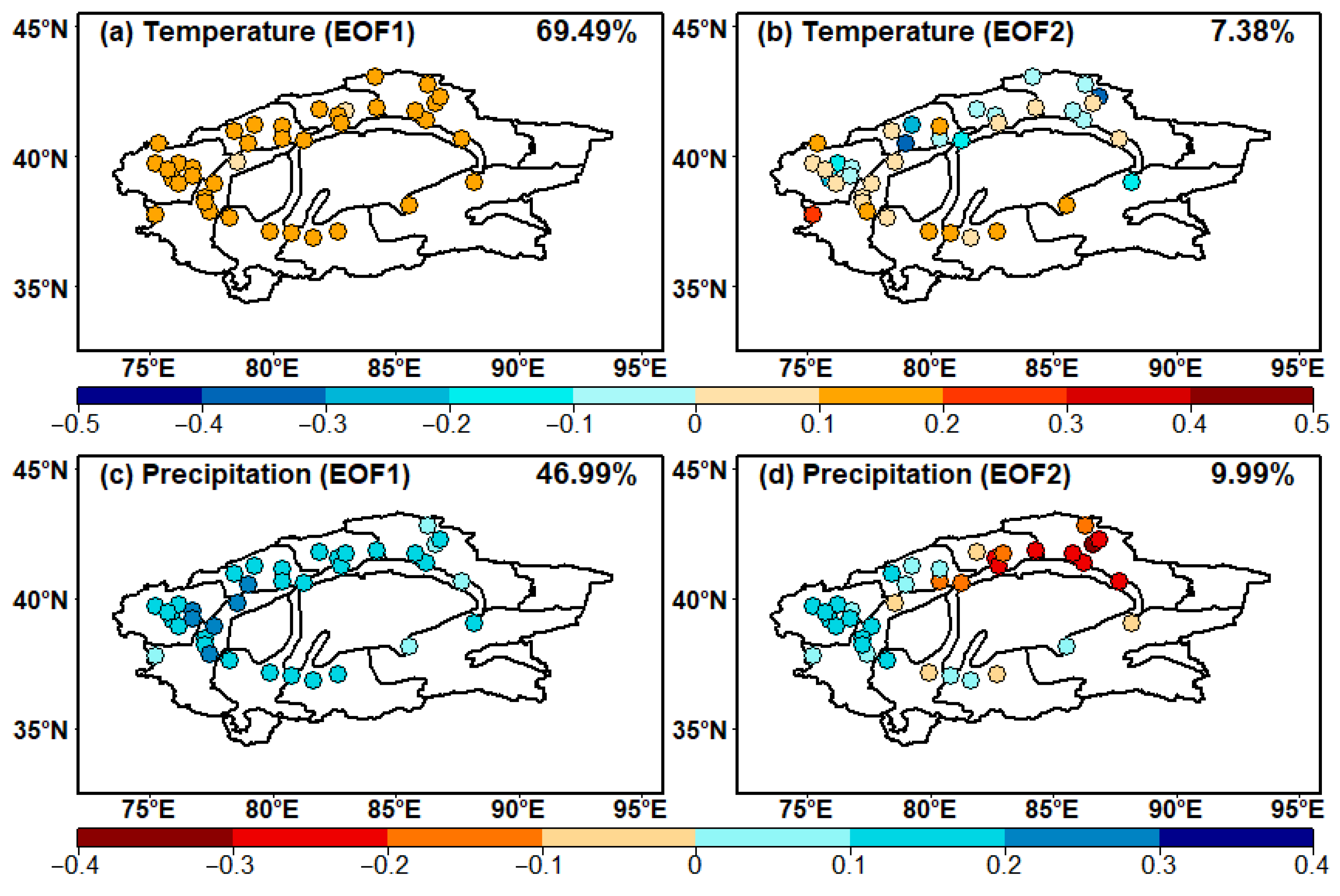


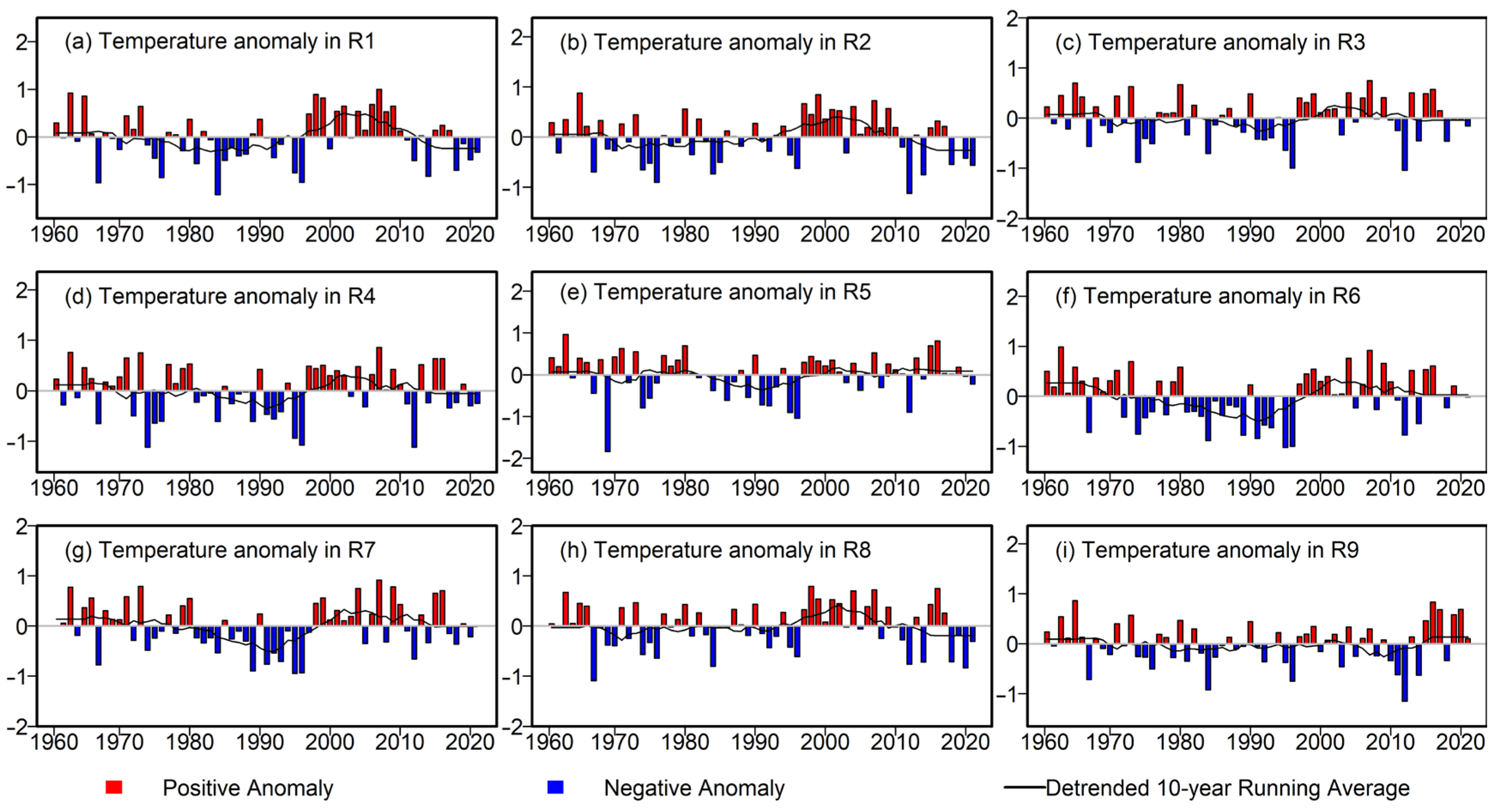



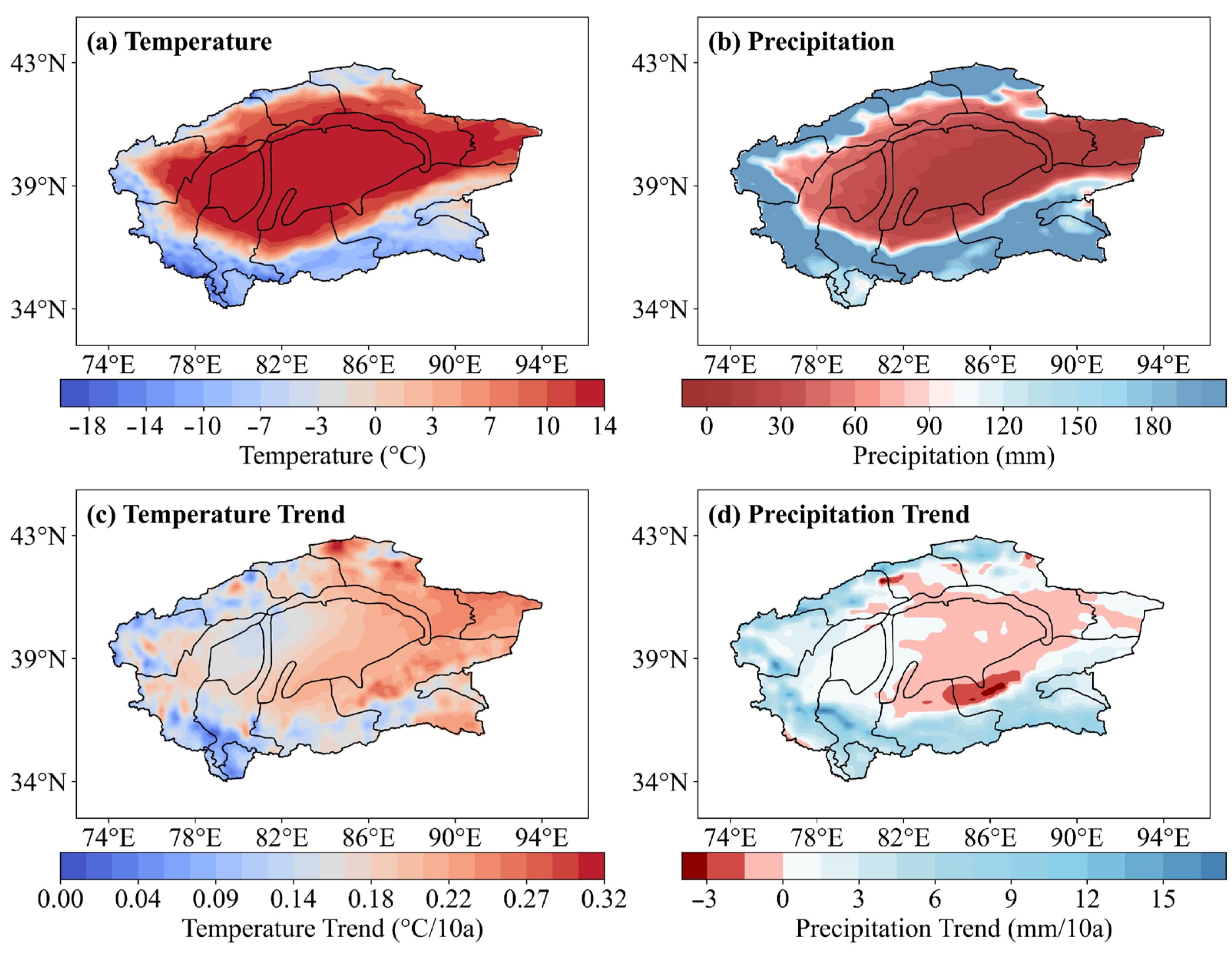
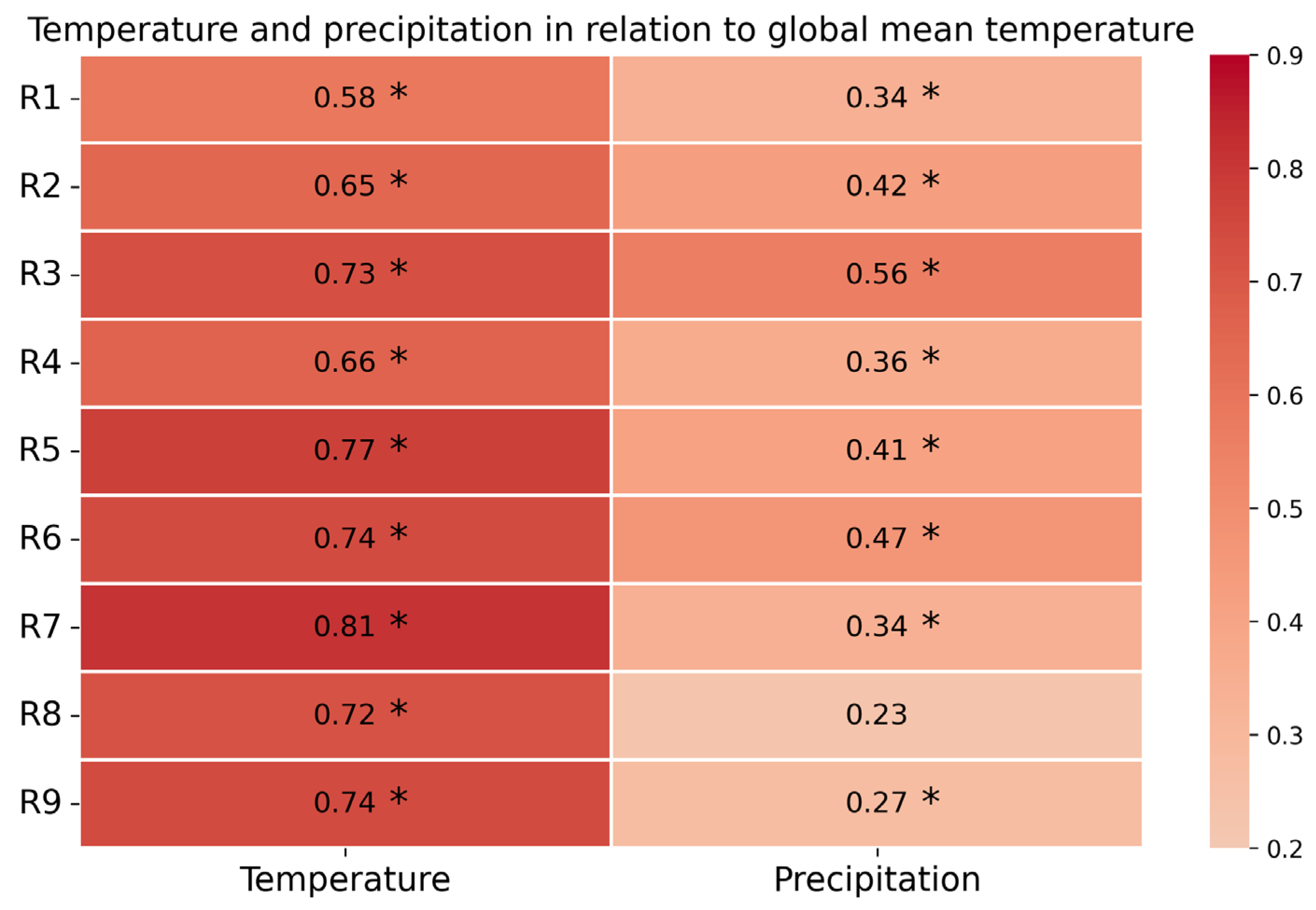
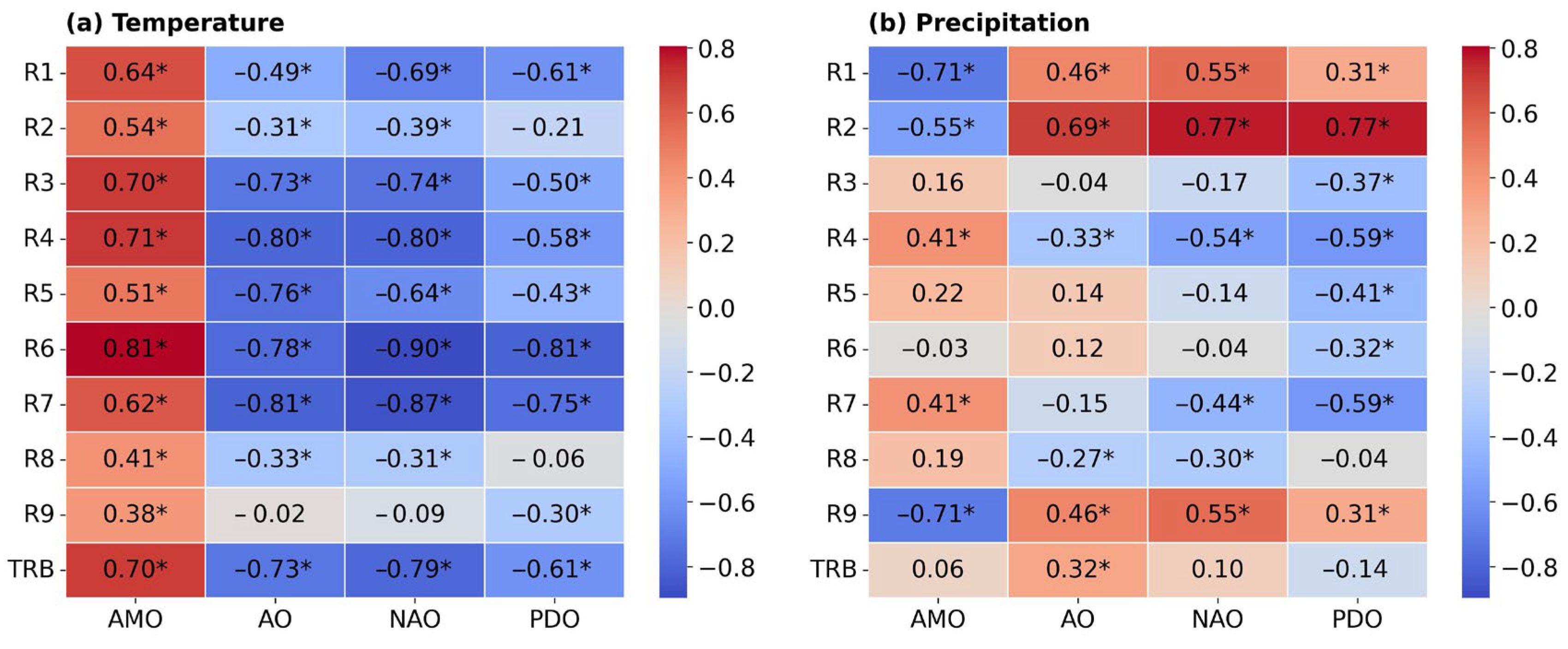
| Primary Zone | TRB | |||||||||
|---|---|---|---|---|---|---|---|---|---|---|
| Secondary Zone | R1 | R2 | R3 | R4 | R5 | R6 | R7 | R8 | R9 | |
| Number of sites | Temperature | 6 | 5 | 6 | 8 | 6 | 4 | 3 | 2 | 2 |
| Precipitation | 5 | 5 | 6 | 7 | 6 | 4 | 3 | 2 | 2 | |
| Serial Number | EOF | Variance Contribution Rate (%) | Cumulative Variance Contribution Rate (%) | |||
|---|---|---|---|---|---|---|
| Temperature | Precipitation | Temperature | Precipitation | Temperature | Precipitation | |
| 1 | 27.55 | 17.68 | 69.49 | 46.99 | 69.49 | 46.99 |
| 2 | 2.93 | 3.76 | 7.38 | 9.99 | 76.87 | 56.98 |
| 3 | 2.16 | 2.03 | 5.45 | 5.39 | 82.31 | 62.37 |
| 4 | 1.48 | 1.62 | 3.73 | 4.29 | 86.04 | 66.66 |
| Secondary Zone | Climatic Tendency Rate (°C/10a, mm/10a) | Mutation Time (Year) | ||
|---|---|---|---|---|
| Temperature | Precipitation | Temperature | Precipitation | |
| R1 | 0.2 | 4.7 | 1994 | 1988, 2009, 2010, 2011, 2012, 2018, 2021 |
| R2 | 0.2 | 6.0 | 1991 | 1978, 2020, 2021 |
| R3 | 0.2 | 12.9 | 1999 | 1995 |
| R4 | 0.2 | 8.8 | 1998 | 2003, 2006, 2008 |
| R5 | 0.3 | 6.8 | 2004 | 2010, 2019, 2021 |
| R6 | 0.3 | 7.4 | 2003 | 2010, 2011, 2012, 2013, 2016, 2019, 2020 |
| R7 | 0.3 | 4.1 | 2001 | 2010, 2011, 2012, 2020, 2021 |
| R8 | 0.2 | 1.9 | 1993 | 1974, 1975, 1981, 1983, 1984, 1985, 1987, 2020, 2021 |
| R9 | 0.2 | 2.5 | 2002 | 2008, 2009, 2010, 2011, 2012, 2020, 2021 |
| MAM | JJA | SON | DJF | |||||
|---|---|---|---|---|---|---|---|---|
| Temperature °C/10a | Precipitation mm/10a | Temperature °C/10a | Precipitation mm/10a | Temperature °C/10a | Precipitation mm/10a | Temperature °C/10a | Precipitation mm/10a | |
| R1 | 0.2 | 2.30 | 0.1 | 1.99 | 0.1 | 0.01 | 0.3 | 0.38 |
| R2 | 0.2 | 0.55 | 0.1 | 3.60 | 0.1 | 1.53 | 0.3 | 0.36 |
| R3 | 0.3 | 1.71 | 0.1 | 7.07 | 0.2 | 3.56 | 0.3 | 0.51 |
| R4 | 0.3 | 1.46 | 0.1 | 4.77 | 0.2 | 1.94 | 0.3 | 0.65 |
| R5 | 0.3 | 1.06 | 0.2 | 4.52 | 0.3 | 0.97 | 0.4 | 0.21 |
| R6 | 0.3 | 1.57 | 0.2 | 4.63 | 0.3 | 0.90 | 0.4 | 0.28 |
| R7 | 0.3 | 0.35 | 0.2 | 2.69 | 0.3 | 0.83 | 0.5 | 0.19 |
| R8 | 0.3 | 0.58 | 0.3 | 0.68 | 0.1 | 0.30 | 0.3 | 0.32 |
| R9 | 0.3 | 0.74 | 0.2 | 1.20 | 0.1 | 0.23 | 0.3 | 0.29 |
Disclaimer/Publisher’s Note: The statements, opinions and data contained in all publications are solely those of the individual author(s) and contributor(s) and not of MDPI and/or the editor(s). MDPI and/or the editor(s) disclaim responsibility for any injury to people or property resulting from any ideas, methods, instructions or products referred to in the content. |
© 2024 by the authors. Licensee MDPI, Basel, Switzerland. This article is an open access article distributed under the terms and conditions of the Creative Commons Attribution (CC BY) license (https://creativecommons.org/licenses/by/4.0/).
Share and Cite
Wang, S.; Aihaiti, A.; Mamtimin, A.; Sayit, H.; Peng, J.; Liu, Y.; Wang, Y.; Gao, J.; Song, M.; Wen, C.; et al. Increases in Temperature and Precipitation in the Different Regions of the Tarim River Basin Between 1961 and 2021 Show Spatial and Temporal Heterogeneity. Remote Sens. 2024, 16, 4612. https://doi.org/10.3390/rs16234612
Wang S, Aihaiti A, Mamtimin A, Sayit H, Peng J, Liu Y, Wang Y, Gao J, Song M, Wen C, et al. Increases in Temperature and Precipitation in the Different Regions of the Tarim River Basin Between 1961 and 2021 Show Spatial and Temporal Heterogeneity. Remote Sensing. 2024; 16(23):4612. https://doi.org/10.3390/rs16234612
Chicago/Turabian StyleWang, Siqi, Ailiyaer Aihaiti, Ali Mamtimin, Hajigul Sayit, Jian Peng, Yongqiang Liu, Yu Wang, Jiacheng Gao, Meiqi Song, Cong Wen, and et al. 2024. "Increases in Temperature and Precipitation in the Different Regions of the Tarim River Basin Between 1961 and 2021 Show Spatial and Temporal Heterogeneity" Remote Sensing 16, no. 23: 4612. https://doi.org/10.3390/rs16234612
APA StyleWang, S., Aihaiti, A., Mamtimin, A., Sayit, H., Peng, J., Liu, Y., Wang, Y., Gao, J., Song, M., Wen, C., Yang, F., Zhou, C., Huo, W., & Wulayin, Y. (2024). Increases in Temperature and Precipitation in the Different Regions of the Tarim River Basin Between 1961 and 2021 Show Spatial and Temporal Heterogeneity. Remote Sensing, 16(23), 4612. https://doi.org/10.3390/rs16234612







